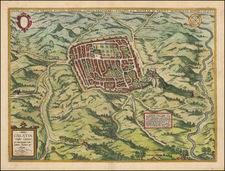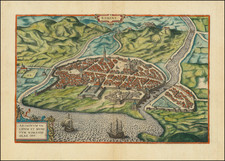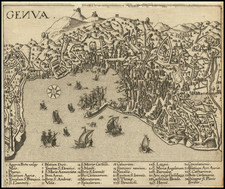Beautiful Original Hand-Color view of Florence
This work was published in Braun & Hogenberg's Civitates Orbis Terrarum, the most prolific compilation of city views published in the 16th Century.
In Florence, we see that the city on the banks of the Arno has spread out to fill the city walls, which were in their sixth iteration by then. The Belvedere fort is seen overlooking the city from the south, something not always included in maps of Florence. Many additional landmarks are instantly recognizable, from the Cathedral de Santa Maria to the Palazzo Vecchio. In the background are the Tuscan hills, dotted with small villages. Two wealthy travelers venture towards the city in the foreground. Despite the remarkable nature of most of this work, one small oversight of perspective is made: the peasants tilling their crops are significantly too large to fit in the houses they occupy.
Georg Braun's commentary on Florence translates as follows:
For just as Venice is called the rich, Milan the great, Genoa the proud, Bologna the fertile, Ravenna the ancient, Naples the noble and Rome the holy city, so Florence is called the beautiful. It has magnificent churches, of which Santa Maria del Fiore is particularly wonderful: it is built of marble and beside it stands a tower, also of marble, quite magnificently furnished with bells.
Georg Braun (1541-1622) was born and died in Cologne. His primary vocation was as Catholic cleric; he spent thirty-seven years as canon and dean at the church St. Maria ad Gradus, in Cologne. Braun was the chief editor of the Civitates orbis terrarum, the greatest book of town views ever published. His job entailed hiring artists, acquiring source material for the maps and views, and writing the text. In this role, he was assisted by Abraham Ortelius. Braun lived into his 80s, and he was the only member of the original team to witness the publication of the sixth volume in 1617.
Frans Hogenberg (ca. 1540-ca. 1590) was a Flemish and German engraver and mapmaker who also painted. He was born in Mechelen, south of Antwerp, the son of wood engraver and etcher Nicolas Hogenberg. Together with his father, brother (Remigius), uncle, and cousins, Frans was one member of a prominent artistic family in the Netherlands.
During the 1550s, Frans worked in Antwerp with the famous mapmaker Abraham Ortelius. There, he engraved the maps for Ortelius’ groundbreaking first atlas, published in Antwerp in 1570, along with Johannes van Deotecum and Ambrosius and Ferdinand Arsenius. It is suspected he engraved the title page as well. Later, Ortelius supported Hogenberg with information for a different project, the Civitates orbis terrarium (edited by Georg Braun, engraved by Hogenberg, published in six volumes, Cologne, 1572-1617). Hogenberg engraved the majority of the work’s 546 prospects and views.
It is possible that Frans spent some time in England while fleeing from religious persecution, but he was living and working in Cologne by 1580. That is the city where he died around 1590. In addition to his maps, he is known for his historical allegories and portraits. His brother, Remigius, also went on to some fame as an engraver, and he died around the same time as his brother.

![[ Florence / Genoa ] Genua Ligurum domina . . . [and] Florentia urbs est Insignis Hetruariae, olim Fluentia dicta . . . By Georg Braun & Frans Hogenberg](https://storage.googleapis.com/raremaps/img/small/96915.jpg)








![[Asti] Asta](https://storage.googleapis.com/raremaps/img/small/59293.jpg)


![[Cuneo] Cuneum](https://storage.googleapis.com/raremaps/img/small/59222.jpg)
![[Vue Perspective de la Grande rue de Naples] (title on verso)](https://storage.googleapis.com/raremaps/img/small/76432.jpg)
